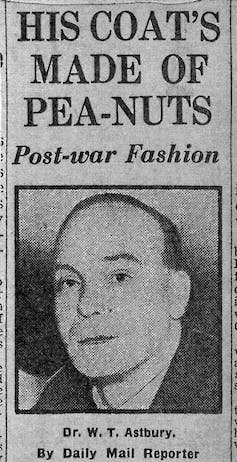![]() Woollen clothing has been around for as long as humans have been wearing clothes and sheep have been domesticated. Indeed, our distant ancestors used sheep for three things: food, clothing and shelter – wool makes good insulation and helps to keep in the warmth.
Woollen clothing has been around for as long as humans have been wearing clothes and sheep have been domesticated. Indeed, our distant ancestors used sheep for three things: food, clothing and shelter – wool makes good insulation and helps to keep in the warmth.
The UK is still one of the largest wool producers in the world and has more than 60 different breeds of sheep.
But with the rise of veganism, many people are now questioning whether it’s ethical to use wool in clothing and fabrics. Vegans don’t wear wool as it is often a by-product of the meat industry.
This is why the charity Peta (The People for the Ethical Treatment of Animals) has launched a US$1 million (£844,000) vegan wool challenge to find the first individual, group, or company that can create a vegan wool material that is “visually, textually and functionally akin to or better than sheep’s wool.”
But it seems that back in the 1940s, textile physicist William Astbury was already on the case and making newspaper headlines for wearing what would today be considered a vegan coat.
For Astbury’s jacket was woven not from wool or other conventional textile materials, but from Ardil, a fibre made from monkey nut, or peanut proteins.
The monkey nut coat
In my book The Man in the Monkeynut Coat: William Astbury and How Wool Wove a Forgotten Road to the Double-Helix, I tell the story of Astbury (and that famous coat), who with his colleague Florence Bell laid the foundations for the discovery of the structure of DNA.
Scientists James Watson and Francis Crick are famous for having first worked out the structure of DNA. But their success came 15 years after Astbury and Bell had first shown that X-rays could actually reveal DNA’s structure.

And this work had a surprising origin, for Astbury’s aim was not to answer grand questions about the secrets of life, but to study the humble wool fibre while working as a lecturer in textile physics at the University of Leeds.
Ever since the Middle Ages, wool and textiles were the economic lifeblood of this Yorkshire city – with mills a major source of employment in the late 19th and early 20th centuries.
In 1928 Astbury came to Leeds and used X-rays to reveal the molecular shape of the proteins in wool fibres. He found that they could be compacted or elongated – rather like a slinky toy. This change in their molecular architecture explained the stretchiness of wool – a property that made it so attractive to the textile industry.
And through it, Astbury left another powerful scientific legacy – thanks to his sporting of that rather unusual “peanut” overcoat.
A future wool?
From the mid-1930s onwards, Astbury, along with his collaborators Albert Chibnall and Kenneth Bailey, filed patents on a process that used solvents such as urea to unravel the precise 3D shape of proteins found in seeds – like the peanut. Their method then refolded them by a kind of molecular origami into insoluble fibres, creating a cheap and abundant raw material for the textile industry.
Sharing his optimism, the company Imperial Chemical Industries bought these patents and built a pilot production plant in Scotland to produce a new textile fibre from peanuts, which they called Ardil and gifted Astbury an overcoat made from it.
During the second world war, wool shortages encouraged investment in Ardil and campaigns were launched to persuade the British public of its benefits. This drive to develop new textile fibres at the time may also have inspired a storyline in the 1951 British comedy film The Man in the White Suit.
In the film, an altruistic chemist invents a fabric that resists wear and stain, but (spoiler alert) his dreams come crashing down when management realises the fabric must be suppressed for economic reasons as it threatens their livelihoods.
Unfortunately, much like the fictional fibre, Ardil did not live up to its promise of saving the British textile industry. But Astbury and his overcoat left an important scientific legacy.
His work remains important because it showcased his lifelong belief that understanding living systems requires solving their molecular architecture. While Ardil did not succeed, Astbury’s research laid the foundation for future innovations in molecular biology and materials science.
This approach, known as structural biology, has since allowed us to understand how the blood protein haemoglobin can carry oxygen around the body, how muscles contract and more recently how the spike protein on the surface of SARS-CoV2 allows the virus to bind and enter human cells.
When Astbury died in 1961, his friend and colleague, the botanist R.D. Preston, fondly remembered him as “a man of many parts – scientist, scholar, musician, bon viveur, humorist, in some ways, a swashbuckler…boisterous to the end with every morning still a Christmas morning.” Maybe to this list of accolades, we should also add a posthumous nomination for the $1 million vegan wool prize.![]()
Kersten Hall, Author and Honorary Fellow, School of Philosophy, Religion and History of Science, University of Leeds
This article is republished from The Conversation under a Creative Commons license. Read the original article.
Source Link: The Man In The Monkey Nut Coat: How A 1940s Scientist Made "Vegan Wool" From Peanuts